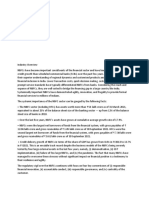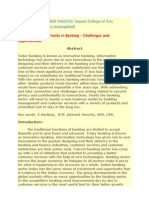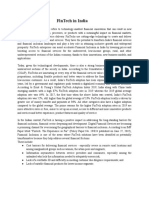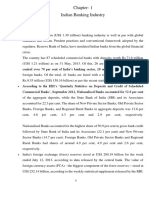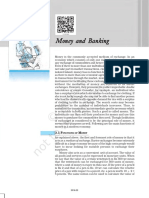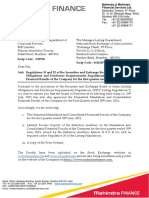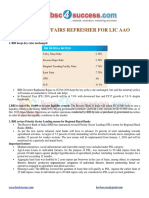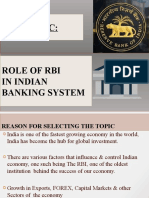Banking Sector in India
Banking Sector in India
Uploaded by
Harshit KokraCopyright:
Available Formats
Banking Sector in India
Banking Sector in India
Uploaded by
Harshit KokraOriginal Title
Copyright
Available Formats
Share this document
Did you find this document useful?
Is this content inappropriate?
Copyright:
Available Formats
Banking Sector in India
Banking Sector in India
Uploaded by
Harshit KokraCopyright:
Available Formats
Banking Sector In India
1. Introduction
“Finance and banking are the backbone of trade, industry, and
business. Today, the financial business fills in as the groundwork of
contemporary business. Any country's capacity to foster lies
vigorously in its financial area.”
The Indian banking industry has been on an upward trajectory
aided by strong economic growth, rising disposable incomes,
increasing consumerism and easier access to credit. (slide –
intro)
▪ India is one of the fastest-growing Fintech markets in the
world. There are currently more than 2,000 DPIIT-recognized
Financial Technology (FinTech) businesses in India, and this
number is rapidly increasing.
India is set to become the third-largest domestic banking
sector by 2050.
As of March 22, 2024, bank credit stood at Rs. 164.34 lakh
crore (US$ 1,968 billion).
Access to the banking system has also gotten better over time
as a result of the continuous endeavors by the Government to
boost banking technology and facilitate growth in
underbanked and nonmetropolitan areas.
Banks added 2,796 ATMs in the first four months of FY23,
against 1,486 in FY22 and 2,815 in FY21.
▪ Indian banking has benefited from high savings rates and
growth in savings as well as disposable income growth.
Currently, there are 52.08 crore beneficiaries holding an
amount of US$ 27.56 billion (Rs. 2.29 trillion) in their
accounts.
According to the RBI, bank deposits stood at Rs. 209.36 trillion
(US$ 2507.62 billion) as of May 3, 2024.
According to RBI’s Scheduled Banks’ Statement, deposits of all
scheduled banks collectively surged by a whopping Rs 2.04
lakh crore (US$ 2,452 billion) as on FY24
The Indian digital consumer lending market is projected to
surpass US$ 720 billion by 2030, representing nearly 55% of
the total US$ 1.3 trillion digital lending market opportunity in
the country
The value of the digital lending market in India was US$ 270
billion in 2022. By 2023, the digital lending market reached
worth around ~ US$ 350 billion. Most of the market was
served by fintech firms and NBFCs.
India's digital lending market witnessed a growth of CAGR
39.5% over a span of 10 years.
▪ Public sector banks accounted for over 57.48% of interest
income in 2023.
▪ The interest income of public banks reached US$ 102.4 billion
in 2023.
▪ In 2023, interest income in the private banking sector reached
US$ 70 billion.
2. Industry Analysis using Porter’s 5 forces model
Porter's Five Forces model applies to the Indian banking industry:
a. Rivalry Among Existing Competitors
The Indian banking sector is highly competitive, with numerous
public, private, and foreign banks vying for market share. This
intense rivalry has led to improved customer service, innovative
products, and competitive pricing.
b. Threat of New Entrants
The threat of new entrants is moderate. High capital
requirements and strict regulations act as barriers to entry, but
the rise of fintech companies has lowered barriers in some areas.
c. Bargaining Power of Suppliers
Suppliers in banking are primarily depositors. Their bargaining
power is low as banks compete aggressively for deposits through
interest rates and services. However, large corporate clients may
have more negotiating power due to their significant deposit
amounts.
d. Bargaining Power of Buyers
The bargaining power of buyers (customers) is high. With many
banking options available, customers can easily switch banks for
better rates or services. This has pushed banks to focus on
enhancing customer experience and offering competitive
products.
e. Threat of Substitute Products
The threat of substitutes is increasing with the rise of alternative
financial services such as peer-to-peer lending, digital wallets,
and cryptocurrencies. These alternatives can offer lower costs
and greater convenience, challenging traditional banks.Overall,
the Indian banking sector is characterized by intense
competition, moderate barriers to entry, low supplier power, high
customer power, and a growing threat of substitutes. Banks must
strategize to maintain their competitive edge in this dynamic
environment.
3. Industry Analysis using PESTEL Framework
A PESTEL analysis examines the macro-environmental factors
affecting the industry:
1. Political Factors: The banking sector is heavily influenced by
government policies and regulations. The Reserve Bank of India
(RBI) plays a crucial role in regulating the banking industry, ensuring
stability and trust in financial systems.
2. Economic Factors: Economic growth directly impacts the banking
sector. India's GDP growth has been robust, leading to increased
demand for banking services. However, inflation and economic
downturns can adversely affect loan repayment rates and
profitability.
3. Social Factors: A growing middle class and increasing financial
literacy are driving the demand for banking services. The shift
towards digital banking is also notable, with more customers
preferring online transactions over traditional banking. ( show per
capita gdp increase)
4. Technological Factors: Rapid technological advancements have
transformed the banking landscape. Digital banking, mobile
payments, and fintech innovations are reshaping how banks operate
and interact with customers.
5. Environmental Factors: Banks are increasingly focusing on
sustainable practices and financing green initiatives. Regulatory
pressures and consumer expectations are pushing banks to adopt
environmentally friendly policies.
(show SDG – re 100, Green Financing)
6. Legal Factors: Compliance with various laws and regulations,
including the Banking Regulation Act and the Prevention of Money
Laundering Act, is essential for banks.
4. Major Trends
Focus on Jan Dhan Yojana
▪ Amounting to Rs. 2,28,057 crore (US$ 27.32 billion) 52.30 crore
number of total beneficiaries banked till May 2024.
▪It provides an avenue for the poor to bring their savings into the
formal financial system, an avenue to remit money to their families
in villages besides taking them out of the clutches of the usurious
money lenders.
Focus on UPI
Digital payments have significantly increased in recent years,
because of coordinated efforts of the Government and RBI
with all the stakeholders, UPI volume for FY24 (until May)
recorded to 27,338. According to the Boston Consulting
Group, PhonePe has 47% of UPI market share followed by
Google Pay (at 34%) in FY23 (April-December). Financial
transactions via digital channels accounted for 92% of the
overall transactions. Out of which, the total share of UPI
transactions was 42% in 9M FY23.
As on April 2024, there were 581 banks actively using UPI.
The total number of Digital transactions as on December
2023, amounted to 15.08 billion, with a total value of Rs. 2.1
trillion (US$ 25.27 billion).
5. Success Defining Metric
Key Metrics in Banking
1. Net Interest Margin (NIM): This metric measures the difference
between the interest income generated by banks and the amount of
interest paid out to depositors, relative to the total earning assets. A
higher NIM indicates better profitability from interest-earning assets,
which is a primary revenue source for banks.
2. Return on Assets (ROA): ROA indicates how effectively a bank is
using its assets to generate profit. It is calculated by dividing net
income by total assets. A higher ROA signifies better asset
management and profitability.
3. Return on Equity (ROE): This metric assesses a bank's
profitability by revealing how much profit a bank generates with the
money shareholders have invested. It is calculated as net income
divided by shareholders' equity. A higher ROE indicates efficient
management and strong financial performance.
4. Loan-to-Deposit Ratio (LDR): The LDR measures a bank's
liquidity by comparing its total loans to its total deposits. A high
ratio may indicate that a bank is lending aggressively, while a low
ratio suggests a more conservative approach to lending and a
greater reliance on deposits.
6. Key Success Factors of Banking in India
Key success factors in the Indian banking industry are shaped by a combination of
technological advancements, customer-centric strategies, regulatory support, and economic
conditions. Here are the main factors contributing to the success of banks in India:
1. Digital Transformation
The Indian banking sector is undergoing significant digital transformation, driven by the need
to modernize operations and enhance customer experiences. Banks are investing heavily in
technologies such as artificial intelligence, blockchain, and cloud computing to streamline
processes, improve security, and offer personalized services. This shift is critical for
maintaining competitiveness in a rapidly evolving market[3][4].
2. Customer-Centric Approach
A strong focus on customer satisfaction is essential. Banks are increasingly adopting a
'customer-first' strategy, which involves understanding customer needs and preferences to
deliver seamless and personalized banking experiences. This includes enhancing service
delivery through digital platforms and improving customer interaction processes[4][5].
3. Regulatory Support
The regulatory environment in India, led by the Reserve Bank of India (RBI), plays a crucial
role in shaping the banking landscape. Initiatives such as the digitalization of lending processes
and the introduction of a national financial information registry are designed to enhance
efficiency and transparency within the banking system. Such regulatory support fosters a
conducive environment for growth and innovation[2][3].
4. Economic Growth and Consumer Demand
The overall economic growth in India, characterized by rising disposable incomes and
increasing consumerism, has bolstered demand for banking services. The expansion of the
fintech sector, projected to reach a valuation of $150 billion by 2025, reflects the growing
integration of technology in financial services, which is vital for banks to tap into new
customer segments and enhance service offerings[2].
5. Innovation and Adaptability
Banks that prioritize innovation and adaptability are more likely to succeed. The ability to
quickly respond to changing market conditions and customer expectations is crucial. This
includes continuous improvement in service offerings and the adoption of new technologies to
enhance operational efficiency and customer engagement[4][5].
6. Strong Risk Management Practices
Effective risk management is fundamental to the success of banks. This involves not only
managing financial risks but also addressing cybersecurity threats and regulatory compliance
challenges. Banks that implement robust risk management frameworks are better positioned to
navigate uncertainties and maintain customer trust[3][5].
7. Employee Competence and Engagement
Investing in employee training and development is essential for fostering a skilled workforce
capable of driving innovation and delivering high-quality customer service. Engaged
employees who are well-versed in the latest technologies and customer service practices
contribute significantly to a bank's success[1][3].
In summary, the key success factors for the banking industry in India revolve around
embracing digital transformation, focusing on customer satisfaction, leveraging regulatory
support, capitalizing on economic growth, fostering innovation, maintaining strong risk
management practices, and investing in employee development. These elements collectively
enhance the resilience and competitiveness of banks in the dynamic Indian market.
7. Key Components of the Banking Industry Value Chain
The banking industry value chain consists of several interconnected activities that create value
for customers and the bank itself. Here are the main components:
### Customer Acquisition and Onboarding
- Attracting new customers through marketing and advertising
- Onboarding customers and opening accounts[1][3]
### Product Development and Management
- Designing and developing banking products like loans, deposits, credit cards, etc.[1]
- Managing product lifecycles and optimizing product mix[1]
### Sales and Distribution
- Selling banking products through branches, online, mobile apps, etc.[1]
- Maintaining sales channels and optimizing distribution[1]
### Funding and Liquidity Management
- Raising funds through deposits, wholesale markets, etc.[1]
- Managing liquidity and interest rate risk[1]
### Credit Risk Management
- Assessing credit risk for loans and other products[1]
- Managing credit risk through underwriting, monitoring, collections, etc.[1]
### Operations and Technology
- Processing transactions and maintaining core banking systems[1][3]
- Ensuring operational efficiency and scalability[1]
### Customer Service and Relationship Management
- Providing customer support through branches, call centers, digital channels[1][3]
- Building long-term customer relationships and loyalty[1]
### Regulatory Compliance and Risk Management
- Complying with banking regulations and guidelines[1][3]
- Managing operational, compliance, and reputational risks[1]
By optimizing each stage of this value chain, banks can enhance efficiency, reduce costs,
improve customer experience, and ultimately drive profitability and growth. Adopting a value
chain approach helps banks stay competitive in the rapidly evolving banking landscape.
8. India vs US Banking industry
Industry Level Compariosn
Average ROE for Indian Banks (2000-2024)
2000-2007: The ROE for Indian banks was generally robust, averaging around 15-20% during
this period, driven by strong economic growth and banking reforms.
2008-2014: Post-global financial crisis, the ROE dipped, averaging around 10-15% as banks
faced asset quality issues and increased provisioning.
2015-2020: The ROE gradually improved again, averaging approximately 12-15% as banks
recovered from previous challenges.
2021-2024: Recent data suggests that Indian banks have seen ROEs in the range of 15-16%,
indicating a strong recovery and profitability in the sector.
Average ROE for U.S. Banks (2000-2024)
2000-2007: U.S. banks enjoyed high ROEs, averaging around 15-20% before the financial
crisis hit.
2008-2014: Following the crisis, ROE plummeted, averaging between 5-10% due to significant
losses and regulatory changes.
2015-2020: The ROE began to recover, averaging about 10-12% as the economy stabilized.
2021-2024: Recent reports indicate that U.S. banks have achieved ROEs of around 12-14%,
with some banks exceeding this range, especially in 2021 when it reached approximately 14%.
Summary of Average ROE
India: Average ROE over 24 years is approximately 12-16%.
U.S.: Average ROE over 24 years is approximately 10-14%.
In conclusion, while both countries have experienced fluctuations in ROE due to economic
conditions and regulatory changes, Indian banks have generally maintained a higher average
ROE compared to their U.S. counterparts over the past two decades.
Comparing top 5 banks in both the economies that define
the industry
Summary Table of Average ROE (2000-2024)
Bank Average ROE (%)
JPMorgan Chase 12-15
Bank of America 8-15
Citigroup 6-12
Wells Fargo 10-14
Goldman Sachs 10-20
These averages reflect the banks' performance over the
specified period, highlighting their ability to generate profits
relative to shareholders' equity.
Indian Banks
Here is a summary table of the average Return on Equity
(ROE) for the specified Indian banks from 2000 to 2024:
Average ROE
Bank (%)
State
Bank of
India
(SBI) 12.5
HDFC
Bank 15.5
ICICI Bank 11.5
Axis Bank 4.5
Kotak
Mahindra
Bank 11.5
You might also like
- BANKING INDUSTRY-Fundamental AnalysisDocument19 pagesBANKING INDUSTRY-Fundamental AnalysisGopi Krishnan.nNo ratings yet
- BANKING INDUSTRY-Fundamental AnalysisDocument19 pagesBANKING INDUSTRY-Fundamental AnalysisGopi Krishnan.nNo ratings yet
- Industry Reports - ISB Consulting Casebook 2021Document36 pagesIndustry Reports - ISB Consulting Casebook 2021BalajiNo ratings yet
- Draft - ShubhamDocument32 pagesDraft - ShubhamHarshit KokraNo ratings yet
- BANK Research ReportDocument12 pagesBANK Research ReportAntraNo ratings yet
- Banking & Finance SectorDocument4 pagesBanking & Finance SectorOMM GOPAL EXIMNo ratings yet
- The Discussions Have Covered Topics Like The UserDocument4 pagesThe Discussions Have Covered Topics Like The Useraditya bNo ratings yet
- CM Project of Mehak Juneja (18BSP1729)Document5 pagesCM Project of Mehak Juneja (18BSP1729)mehak junejaNo ratings yet
- Objectives of The StudyDocument51 pagesObjectives of The StudyMmp AbacusNo ratings yet
- Lets Revisit OMDocument10 pagesLets Revisit OMNihar AkunuriNo ratings yet
- Banking - Positives NegativesDocument9 pagesBanking - Positives NegativesraviNo ratings yet
- Indian Bank - CompanyAnalysis7687888989Document17 pagesIndian Bank - CompanyAnalysis7687888989yaiyajieNo ratings yet
- Ey The Next Phase of Digital Lending in IndiaDocument52 pagesEy The Next Phase of Digital Lending in IndiaArindam MondalNo ratings yet
- Sapm Project ReportDocument25 pagesSapm Project ReportAdarshNo ratings yet
- Core Modernisation Enhancing The Digital Transformation 1728908483Document24 pagesCore Modernisation Enhancing The Digital Transformation 1728908483shekharNo ratings yet
- Retail BankingDocument15 pagesRetail BankingjazzrulzNo ratings yet
- India'S Credit Ecosystem: A Review ofDocument27 pagesIndia'S Credit Ecosystem: A Review ofMohit BoralkarNo ratings yet
- Impact of Technological Changes On Customer: Experience in Banking Sector-A Study of Select Banks in Madhya PradeshDocument12 pagesImpact of Technological Changes On Customer: Experience in Banking Sector-A Study of Select Banks in Madhya PradeshSiddharthJainNo ratings yet
- Vision of Microfinance in IndiaDocument31 pagesVision of Microfinance in IndiaBobby ShrivastavaNo ratings yet
- JETIR2305232Document10 pagesJETIR2305232Amit BrarNo ratings yet
- Indian Financial SystemsDocument6 pagesIndian Financial SystemsParang MehtaNo ratings yet
- Sana DessertationDocument80 pagesSana DessertationNaghul KrishnaNo ratings yet
- Shyamala Gopinath: Retail Banking - Opportunities and ChallengesDocument5 pagesShyamala Gopinath: Retail Banking - Opportunities and ChallengesAmol ShindeNo ratings yet
- Financial Services Unit IVDocument19 pagesFinancial Services Unit IVghoshpreetu11No ratings yet
- UntitledDocument5 pagesUntitledRajendra BambadeNo ratings yet
- ScriptDocument2 pagesScriptHarshit KokraNo ratings yet
- Lecture 1.5 Recent Development in BankingDocument6 pagesLecture 1.5 Recent Development in BankingCharu Saxena16No ratings yet
- Project On Banking SectorDocument5 pagesProject On Banking SectorNikita BagulNo ratings yet
- Retail Banking JUNE 2022Document10 pagesRetail Banking JUNE 2022Rajni KumariNo ratings yet
- UPSC Economy GS-3 SummaryDocument153 pagesUPSC Economy GS-3 SummaryAjay SinghNo ratings yet
- Banking Industry-Final Report Group 18Document14 pagesBanking Industry-Final Report Group 18Pranav KumarNo ratings yet
- Industry Overview - IndianDocument2 pagesIndustry Overview - IndianhrishikeshsmanoharNo ratings yet
- Banking Retail ProductsDocument7 pagesBanking Retail ProductsaadisssNo ratings yet
- NBFC-2 BCGDocument34 pagesNBFC-2 BCGvamsi.iitkNo ratings yet
- 2015iciee - India3 Challenges PDFDocument7 pages2015iciee - India3 Challenges PDFVishakha RathodNo ratings yet
- Banking Sector: 1.1 Introduction To The TaskDocument23 pagesBanking Sector: 1.1 Introduction To The TaskRIYA CHALKENo ratings yet
- Emerging Trends of Banking SystemDocument12 pagesEmerging Trends of Banking SystemChoden ChdnNo ratings yet
- T R A N S F O R M A T I O N: THREE DECADES OF INDIA’S FINANCIAL AND BANKING SECTOR REFORMS (1991–2021)From EverandT R A N S F O R M A T I O N: THREE DECADES OF INDIA’S FINANCIAL AND BANKING SECTOR REFORMS (1991–2021)No ratings yet
- Banking Sector AnalysisDocument9 pagesBanking Sector AnalysisNitesh Kr SinghNo ratings yet
- BANKING2Document21 pagesBANKING2Ansh JunejaNo ratings yet
- New Age of Banking-1 PDFDocument9 pagesNew Age of Banking-1 PDFsomprakash giriNo ratings yet
- Descriptive Questions For RBI Grade B Exam: Important NoteDocument12 pagesDescriptive Questions For RBI Grade B Exam: Important NoteVishal SonkarNo ratings yet
- ChapterDocument16 pagesChapterAjay YadavNo ratings yet
- Kotak FinalDocument46 pagesKotak FinalRahul FaliyaNo ratings yet
- KPMG CII Indian BankingDocument32 pagesKPMG CII Indian BankingMukesh Pareek100% (1)
- FinTech in IndiaDocument6 pagesFinTech in IndiaMARPU RAVITEJANo ratings yet
- Case Study Solution IBS HyderabadDocument5 pagesCase Study Solution IBS HyderabadDeepak BhatiaNo ratings yet
- Pioneers of Change Building Resilient Nbfcs FinalDocument32 pagesPioneers of Change Building Resilient Nbfcs FinalSachin KesarwaniNo ratings yet
- Summer Project: Submitted To: Submitted byDocument12 pagesSummer Project: Submitted To: Submitted byAtul Kumar SrivastavNo ratings yet
- Financial Inclusion and Information TechnologyDocument8 pagesFinancial Inclusion and Information TechnologydhawanmayurNo ratings yet
- Introduction To The CompanyDocument28 pagesIntroduction To The CompanyMukesh ManwaniNo ratings yet
- Banking Module 1Document26 pagesBanking Module 1mansisharma8301No ratings yet
- MA0044Document11 pagesMA0044Mrinal KalitaNo ratings yet
- Global in ContextDocument9 pagesGlobal in ContextOluwadunsin OlajideNo ratings yet
- Chapter-1 Indian Banking IndustryDocument51 pagesChapter-1 Indian Banking IndustryRohit SolankiNo ratings yet
- DR T N AnuradhaDocument4 pagesDR T N AnuradhaOm PatilNo ratings yet
- Beepedia Weekly Current Affairs (Beepedia) 1st-8th January 2023Document38 pagesBeepedia Weekly Current Affairs (Beepedia) 1st-8th January 2023Sovan KumarNo ratings yet
- Retail BankingDocument10 pagesRetail BankingAtul MadNo ratings yet
- Chapter 2 ShashankDocument10 pagesChapter 2 ShashanksanjayramaswamNo ratings yet
- Hospitality Indusrty Top 10Document6 pagesHospitality Indusrty Top 10pooja36No ratings yet
- Rau's IAS Focus Monthly Magazine April 2024Document160 pagesRau's IAS Focus Monthly Magazine April 2024vikas ahlawatNo ratings yet
- Introduction To Private and Public BankDocument17 pagesIntroduction To Private and Public BankAbhishek JohariNo ratings yet
- Aman Jaiswal MRPDocument62 pagesAman Jaiswal MRPAli ShaikhNo ratings yet
- Optimum Daily Current Affairs 1 April by Karan SinhaDocument9 pagesOptimum Daily Current Affairs 1 April by Karan Sinhaaditya vermaNo ratings yet
- 1gold Report PDFDocument86 pages1gold Report PDFrahul84803No ratings yet
- Consumer Behavior Analysis in Selection of A BankDocument1 pageConsumer Behavior Analysis in Selection of A Banksujata_patil11214405No ratings yet
- Money and Banking Money and Banking Money and Banking Money and Banking Money and BankingDocument17 pagesMoney and Banking Money and Banking Money and Banking Money and Banking Money and BankingDhrUv GuptaNo ratings yet
- Knowledge ManagementDocument46 pagesKnowledge ManagementVishakha RathodNo ratings yet
- White and Black Professional Magazine CoverDocument30 pagesWhite and Black Professional Magazine CovershubhamgaurNo ratings yet
- Internship ReportDocument42 pagesInternship ReportnaomiinjesuschristNo ratings yet
- Foreign Banks: Ben Mathews T4 MbaDocument11 pagesForeign Banks: Ben Mathews T4 MbaBen MathewsNo ratings yet
- Foreign Currency Convertible Bond 100 Marks ProjectDocument47 pagesForeign Currency Convertible Bond 100 Marks ProjectSalman Corleone100% (1)
- Mrunal Sir's Economy 2020 Batch - Handout PDFDocument21 pagesMrunal Sir's Economy 2020 Batch - Handout PDFssattyyaammNo ratings yet
- MAHINDRA AND MAHINDRA FINANCIAL SERVICES LTD. Financial Results July 2021Document20 pagesMAHINDRA AND MAHINDRA FINANCIAL SERVICES LTD. Financial Results July 2021mukesh bhattNo ratings yet
- Development BankDocument5 pagesDevelopment BankAbhijit GogoiNo ratings yet
- Final Project Kyc FinalDocument70 pagesFinal Project Kyc FinalAnonymous HackerNo ratings yet
- ANNUALREPORTRBIOSC19A18Document69 pagesANNUALREPORTRBIOSC19A18shubhc65No ratings yet
- Unit 1 Elements of Banking - 1Document36 pagesUnit 1 Elements of Banking - 1harshita bhatiaNo ratings yet
- ICICI ValuationDocument62 pagesICICI ValuationRutuja NagpureNo ratings yet
- Maharaja Surajmal Institution: Minor Project ReportDocument52 pagesMaharaja Surajmal Institution: Minor Project ReportRaviNo ratings yet
- MCWQS For All XamsDocument97 pagesMCWQS For All Xamsvini_anj3980No ratings yet
- Changing Landscape of BankingDocument18 pagesChanging Landscape of BankingAkash YadavNo ratings yet
- CA Refresher For LIC AAODocument70 pagesCA Refresher For LIC AAOBibhuti bhusan maharanaNo ratings yet
- Banking Part - 01Document8 pagesBanking Part - 01Gurmukh singhNo ratings yet
- Application Form 7202007938108Document5 pagesApplication Form 7202007938108Sanjay SolankiNo ratings yet
- Final Project of Indusind BankDocument104 pagesFinal Project of Indusind Banknikhil chikhaleNo ratings yet
- Homehome: Rbi Advises Banks To Preserve CCTV Recordings of Operations From November 8 To December 30, 2016Document44 pagesHomehome: Rbi Advises Banks To Preserve CCTV Recordings of Operations From November 8 To December 30, 2016Arindam KarNo ratings yet
- NCERT Solutions For Class 11th: CH 1 Indian Economy On The Eve of IndependenceDocument53 pagesNCERT Solutions For Class 11th: CH 1 Indian Economy On The Eve of IndependenceSai KrishnaNo ratings yet
- HDFC BankDocument138 pagesHDFC BankKrishna KanthNo ratings yet
- Role of Rbi in Indian Banking System 2022Document22 pagesRole of Rbi in Indian Banking System 2022ayushNo ratings yet
























